Method Article
アイス結合タンパク質の調査用のLabVIEWオペ新規ナノリッター浸透圧計
要約
また、不凍タンパク質として知られている氷結合タンパク質(IBPS)は、氷の成長を阻害し、組織の凍結保存に使用するための有望な添加剤です。 IBPSを調査するために使用する主なツールは、ナノリットル浸透圧計です。我々は、光学顕微鏡に取り付けられた家に設計された冷却ステージを開発し、特注のLabVIEWのルーチンを使用して制御する。ナノリットル浸透圧計は、超高感度の方法で試料温度を操作ここで説明する。
要約
Ice-binding proteins (IBPs), including antifreeze proteins, ice structuring proteins, thermal hysteresis proteins, and ice recrystallization inhibition proteins, are found in cold-adapted organisms and protect them from freeze injuries by interacting with ice crystals. IBPs are found in a variety of organism, including fish1, plants2, 3, arthropods4, 5, fungi6, and bacteria7. IBPs adsorb to the surfaces of ice crystals and prevent water molecules from joining the ice lattice at the IBP adsorption location. Ice that grows on the crystal surface between the adsorbed IBPs develops a high curvature that lowers the temperature at which the ice crystals grow, a phenomenon referred to as the Gibbs-Thomson effect. This depression creates a gap (thermal hysteresis, TH) between the melting point and the nonequilibrium freezing point, within which ice growth is arrested8-10, see Figure 1. One of the main tools used in IBP research is the nanoliter osmometer, which facilitates measurements of the TH activities of IBP solutions. Nanoliter osmometers, such as the Clifton instrument (Clifton Technical Physics, Hartford, NY,) and Otago instrument (Otago Osmometers, Dunedin, New Zealand), were designed to measure the osmolarity of a solution by measuring the melting point depression of droplets with nanoliter volumes. These devices were used to measure the osmolarities of biological samples, such as tears11, and were found to be useful in IBP research. Manual control over these nanoliter osmometers limited the experimental possibilities. Temperature rate changes could not be controlled reliably, the temperature range of the Clifton instrument was limited to 4,000 mOsmol (about -7.5 °C), and temperature recordings as a function of time were not an available option for these instruments.
We designed a custom-made computer-controlled nanoliter osmometer system using a LabVIEW platform (National Instruments). The cold stage, described previously9, 10, contains a metal block through which water circulates, thereby functioning as a heat sink, see Figure 2. Attached to this block are thermoelectric coolers that may be driven using a commercial temperature controller that can be controlled via LabVIEW modules, see Figure 3. Further details are provided below. The major advantage of this system is its sensitive temperature control, see Figure 4. Automated temperature control permits the coordination of a fixed temperature ramp with a video microscopy output containing additional experimental details.
To study the time dependence of the TH activity, we tested a 58 kDa hyperactive IBP from the Antarctic bacterium Marinomonas primoryensis (MpIBP)12. This protein was tagged with enhanced green fluorescence proteins (eGFP) in a construct developed by Peter Davies' group (Queens University)10. We showed that the temperature change profile affected the TH activity. Excellent control over the temperature profile in these experiments significantly improved the TH measurements. The nanoliter osmometer additionally allowed us to test the recrystallization inhibition of IBPs5, 13. In general, recrystallization is a phenomenon in which large crystals grow larger at the expense of small crystals. IBPs efficiently inhibit recrystallization, even at low concentrations14, 15. We used our LabVIEW-controlled osmometer to quantitatively follow the recrystallization of ice and to enforce a constant ice fraction using simultaneous real-time video analysis of the images and temperature feedback from the sample chamber13. The real-time calculations offer additional control options during an experimental procedure. A stage for an inverted microscope was developed to accommodate temperature-controlled microfluidic devices, which will be described elsewhere16.
The Cold Stage System
The cold stage assembly (Figure 2) consists of a set of thermoelectric coolers that cool a copper plate. Heat is removed from the stage by flowing cold water through a closed compartment under the thermoelectric coolers. A 4 mm diameter hole in the middle of the copper plate serves as a viewing window. A 1 mm diameter in-plane hole was drilled to fit the thermistor. A custom-made copper disc (7 mm in diameter) with several holes (500 μm in diameter) was placed on the copper plate and aligned with the viewing window. Air was pumped at a flow rate of 35 ml/sec and dried using Drierite (W.A. Hammond). The dry air was used to ensure a dry environment at the cooling stage. The stage was connected via a 9 pin connection outlet to a temperature controller (Model 3040 or 3150, Newport Corporation, Irvine, California, US). The temperature controller was connected via a cable to a computer GPIB-PCI card (National instruments, Austin, Texas, USA).
プロトコル
0。予備手続き
- ガラスが溶液注入用キャピラリー。キャピラリープラー(ナリシゲ、東京、日本)を用いて、ガラスキャピラリーマイクロチューブから微小開口(ブランド社、ヴェルトハイム、ドイツ)を鋭いピペットを準備します。開口部の大きさは、きれいな水で細かい泡立ちを取得するために毛細血管を介して空気を通過させることによって検証する必要があります。毛細血管が閉じているなら、1つはその縁を壊すことによって、それを開くことができます。これは、管壁を含む水に対して軽く押したり傷ついたりすることによって達成することができる。開口部はほぼ遮断されますが、サブミリメートルの気泡の形成を可能にするために十分に開放されていることをキャピラリーなどを準備します。
- 銅ディスクのクリーニングは。再蒸留水で洗浄した後、0.1%マイクロ-90石鹸(コール-パーマー、ヴァーノンヒルズ、イリノイ州、米国)で10分間銅ディスクを超音波洗浄します。イソプロパノール(技術)ソリューションにディスクを導入し、10分間超音波処理し、再び。フィン同盟国、ろ過された空気を使用してディスクを乾かしてください。このクリーニングステージは実験間IBP汚染を避けるために重要です。
- ダブルレイヤーカバーガラスアセンブリ。カバーガラスアセンブリは、カバーガラスの表面に水分を凝縮させずに試料の観察を可能にするために調製した。これは、ホットグルーガンで接着したカバーガラスの間に2 DRIERITE(ワシントン州ハモンドDRIERITE、クセニア、オハイオ州、米国)粒子(直径2mm)を置くことによって達成された。この構成では、サンプルを低温に冷却し、観察窓の上に乾燥した空気を爆破する必要があると削除されたときに視界を遮る可能性が結露を防止。
1。冷却ステージセットアップ
- 4ミリメートル、内径タイゴンチューブ(サンゴバン社、パリ、フランス)への冷却段階の水流入口と出口を接続し、水ポンプへの水の流入口チューブを接続します。
- 冷却ステージトンの入口に4ミリメートル内径タイゴンチューブを接続乾燥した空気をお届けO。空気はインラインDRIERITEカラムを用いて乾燥した。
- 空気や水ポンプを操作してください。冷却素子はヒートシンクなしで実行されるべきではないことに注意してください。
- 温度調節器、カメラ、およびLabVIEWのルーチンをオンにします。
2。試料調製
- ディスクを介して掘削さ500μmの孔を有する直径7mmの銅ディスクの裏側に浸油B(Cargille研究所、シーダーグローブ、ニュージャージー州、米国)の3-4液滴を配置します。
- 下向きにイマージョンオイル側と冷却ステージ上の銅ディスクを置きます。
- 2ミリリットルガラスシリンジ(Poulten·グラーフ、ヴェルトハイム、ドイツ)にもう一方の端に接続さ0.7ミリメートル、内径タイゴンチューブにキャピラリーチューブ(鈍端)を接続します。
- 事前の毛細管を使用した場合と、(予備手順を参照)開口部が適切なサイズであることを保証するために毛細血管の小さな開口部をチェックします。
- ゆっくりGLAを挿入ガラスキャピラリーが0.1を含むまでssは準備のIBPタンパク質試料管へのキャピラリ(20 mM CaCl 2およびpH8の25mMトリス-HCl、2.4μMのMpが IBP-GFP、準備の詳細については参考文献10を参照)、ガラスシリンジを引くタンパク質溶液の液。
- LabVIEWソフトウェアを経由してビデオの録画を開始します。
- 冷却ステージ上の銅ディスクの穴の1つにガラスキャピラリー(タンパク質溶液を含有する)の鋭いエッジを挿入します。
- (オリンパス、東京、日本、10倍対物レンズ)顕微鏡で観察しながら、慎重にガラスキャピラリー先端で液浸油の層に浸透し、タンパク質の少量(〜10 NL)を提供するガラスシリンジを(非常に微妙)を押してください200μmの液滴を作成するためのソリューションを提供します。
- 二重層カバーガラスアセンブリ(予備手順を参照してください)と冷却ステージに穴をカバーしています。
3。 THの活性測定
- プリSS冷房ボタン、-40に温度を℃に設定
- 当初、溶液滴は明らかであろう。 -35〜-30℃の中で、典型的には、低温度、℃で、液滴の色が変わり、溶液が凍結されたことを示す。サンプルは凍結した直後に大量の氷が溶け始めるまで、ゆっくりと温度を上昇させる。温度が徐々に増加し、サンプルを完全に溶融する可能性があり、温度のオーバーシュートを避けるために必要である。
- 50倍の対物レンズに切り替えて温度を調整することで氷を溶かし始める。この調整は、対話形式で行われ、最終的なステップは、通常、0.002℃の小さい温度ステップを使用して実行され単結晶が残るまで溶融し続けています。結晶の最終的なサイズは10μm前後となるはずです。融解が消滅したた最高温度は融点であると判断され、後にビデオ分析の段階で正確に決定されます。
- 結晶の融点以下の摂氏の数百分のに温度を設定し、10分遅れとの温度勾配を開始します。必要に応じて、ランピング速度を調整します。この間、結晶がIBPSにさらされることになる。
- 10分間の露光時間が終了すると、温度は、LabVIEWルーチンの制御下で自動的に減少します。
- 温度が下がるなどの結晶形を観察します。ある時点で、氷晶の突然のバーストが観察されることがあります。これが起こる温度は、結晶のバースト温度として注目されている。
- 正確な融点とバーストの温度を決定するために、ビデオ分析を使用しています。まず、ビデオ分析を使用することにより、正確な融点を見つける。融解が消滅したた最高温度は融点であると判断されたことを思い出してください。スプレッドシートプログラムでこの融点を文書化します。その後、正確な結晶バースト温度を決定し、この値を記録同様に。融点と凝固点の差、または水晶バースト温度は、IBPの溶液の熱ヒステリシス活性である。
4。時間依存のTH活性の測定
- 氷の単結晶を準備するためにセクション3.1から3.3で説明されたプロトコルに従ってください。
- 結晶を形成した後、必要に応じてランプの遅延時間を設定して、ランプをオンにします。
- 温度は自動的に一度ランプ遅延時間が経過した(事業者の要件に応じて)一定の割合で減少します。
- 結晶のバーストが起こる温度を文書化します。露光時間を(結晶形成と結晶バースト間の時間)を計算します。
- 様々な遅延時間の実験を繰り返し、TH活性の時間依存性を評価するために露光時間の関数としてのTH活性をプロットします。
結果
THの時間依存性の測定
LabVIEWのオペナノリットル浸透圧計は、正確なTHの活性測定の性能を容易にします。一定温度の低減率は、TH時間依存性の測定を可能にした。ナノリットル浸透圧計では有効になって正確な温度制御は、これらの実験のために重要だった。溶液中IBPSに氷晶の露光時間は、水晶(クリスタルバースト)の周りに氷の急激な成長まで、結晶の形成からの時間(溶融プロセスの終了)として定義されています。我々はIBPSに氷の結晶の露光時間が決定的にTHの活動に影響を与えたことがわかった。 IBPの露出(数秒)の短い期間では 、MP IBP-GFPの溶液(2.4μM)( 図5)の低THの活動を作り出した。それは4分のIBP露出でプラトーに達するまでのTH活動はIBP露光時間とともに増加した。高いIBPの濃度で、プレートauのは、短い時間に達しました。
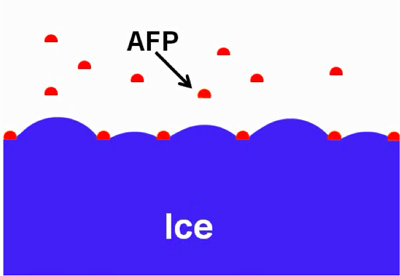
図1:氷に吸着IBPSを示す模式図。 10の許可を得て採択された。
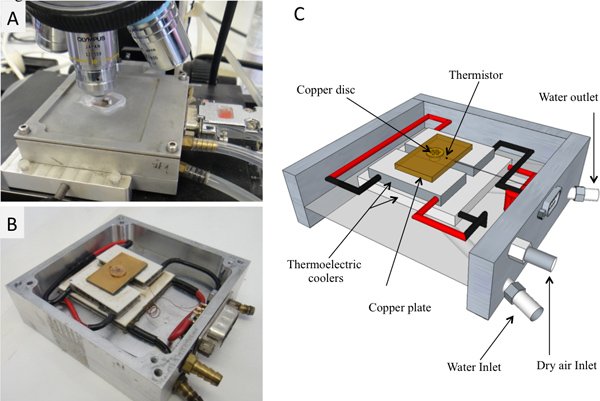
図2冷却ステージ。 A)は顕微鏡のチューブに接続されています。 B)の上側のリード線なし。 C)の模式図。
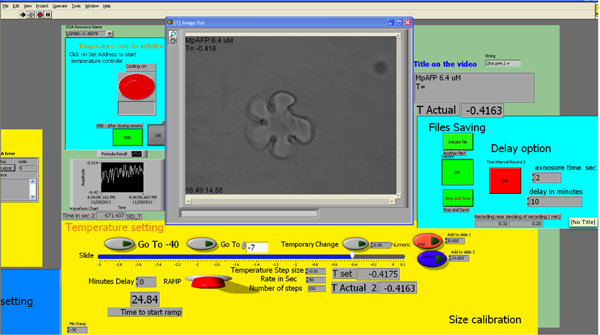
図3。LabVIEWインタフェースのスクリーンショット。 塩素拡大図を表示するには、ここをICK。
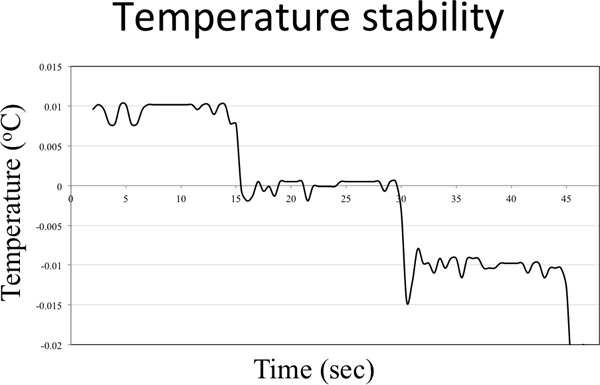
図4。温度安定性のグラフ。温度コントローラは、温度0.01℃毎15秒を下げるために設定されていました。
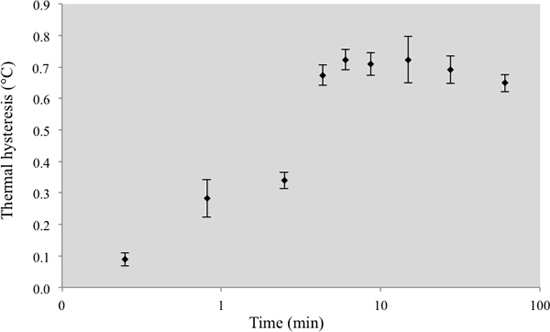
図5 IBPSに氷結晶露光時間の関数として mp IBP THの活動。それぞれの時点では、3月6日の実験の平均値である。
ディスカッション
この作品は、特別な温度制御とTH活動の正確な測定を可能にするコンピュータ制御によるナノリットル浸透圧計の動作を示しています。任意の温度に敏感なシステムでは、不要な温度勾配は避けなければならない。ここで提示装置内の温度勾配を避けるために、試験液滴が銅ディスク冷却ステージ(ステップ2.7)の穴の中央に配置しなければならない。さらに、単結晶は、液滴の中心ではなく、エッジ付近である必要があります(ほとんどの場合、これは自発的に起こります)。説明時間依存性は、冷却速度がTHの測定値に影響を与える可能性があることを示しています。したがって、私たちは、結晶が冷却する前に溶液に暴露された時間のレポートと同様に、冷却速度を含め示唆している。我々は、典型的には0.01で温度をランプダウンする前に、10分を待っていた℃はそれぞれ4秒を繰り返します。
LabVIEWで制御された共olingステージは、マイクロ流体デバイスは熱的に操作することができた上で倒立顕微鏡で使用するために適応されました。このシステムは、eGFPの9、10、16のタグが付いた氷の結晶とIBPSを含む溶液交 換実験の性能を容易にします。 LabVIEWで制御されたシステムは、指定された適応電気回路を経由して3040温度コントローラを接続することにより、クリフトン·ステージに適合させることができる。このようなシステムは、デイビスラボ17に運営されています。 LabVIEWソフトウェアとクリフトン·ステージのための指定適応電気回路設計のリクエストも承ります。
結論として、我々は温度とリアルタイム解析用のLabVIEWルーチンを介してビデオ·インターフェースとの間で調整温度上昇と減少(0.002℃感度を持つ)、速度の敏感な制御および操作を容易にナノリットル浸透圧計を説明します。このシステムはimportanアール再現レート制御実験を行うことができます氷と一緒にIBPの相互作用の動態を調査するためのトン。このような実験はIBPSの作用機序を取り巻くいくつかの長い議論の問題に対処することができます。
開示事項
特別な利害関係は宣言されません。
謝辞
この研究は、ISF、NSFとERCによってサポートされていました。我々はランディミルフォード、マイケル·コーレン、ダグ·シェーファー、ジェレミー·デニソンから温度段階で技術的なヘルプを承認したいと思います。ソフトウェア開発と援助はまた、陳ディ徐ラジェッシュSannareddy、とスミットBhattacharyによって提供されました。我々 は 、MPのIBPタンパク質と有用な議論を私たちの共同研究者教授ピーターL.デービス博士とローリーA.グラハムに感謝したいと思います。また、研究室のメンバードクターマヤバーDolev、Yangzhong秦博士Yelizチェリック博士ナタリアPertaya、Ortal Mizrahy、およびそれらのユーザーからのフィードバックのためのガイShlomitに感謝します。
資料
| Name | Company | Catalog Number | Comments |
| 名前 | 会社 | カタログ番号/モデル | 注釈 |
| イマージョンオイルタイプB | Cargille研究所 | 16484 | |
| DRIERITE | ワシントン州ハモンドDRIERITE | 043063 2270グラム | |
| マイクロ90洗浄液 | コール - パーマー | EW-18100から11 | |
| プーラーをキャピラリ | ナリシゲ | PB-7 | |
| ガラス毛細管 | ブランドGNBH | 7493 21 | 長い75ミリメートル、直径1.15 |
| 温度コントローラ | ニューポート、アーバイン、カリフォルニア州、アメリカ合衆国 | モデル3040 | モデル3040 |
| 光学顕微鏡 | オリンポス | モデルBH2 | |
| 10倍の対物レンズ | オリンポス | Sプラン10、0.3、160/0.17 | |
| 50倍の対物レンズ | ニコン | CFの計画、50X/0.55 EPI ELWD | |
| CCDカメラ | Provideo | CVC-140 | |
| タイゴンチューブ | サンゴバン、パリ、フランス | タイゴン製剤S-50-HLチューブ | |
| ガラス注射器(2ミリリットル) | Poulten·グラーフ、ヴェルトハイム、ドイツ | 7 10227 | |
| GPIB-PCIカード | ナショナルインスツルメンツでは、米国テキサス州オースティン | 778032から01 | |
| ビデオフレームGRAbber IMAQ PCI-1407 | ナショナルインスツルメンツでは、米国テキサス州オースティン | 322156B-01 | |
| LabVIEWシステム設計ソフトウェア | ナショナルインスツルメンツでは、米国テキサス州オースティン | バージョン8 | |
| DivXの著者ソフトウェア | DIVX LLCは、サンディエゴ、CA、USA |
参考文献
- DeVries, A. L. Glycoproteins as biological antifreeze agents in antarctic fishes. Science. 172, 1152-1155 (1971).
- Worrall, D., Elias, L., Ashford, D., Smallwood, M., Sidebottom, C., Lillford, P., Telford, J., Holt, C., Bowles, D. A carrot leucine-rich-repeat protein that inhibits ice recrystallization. Science. 282, 115-117 (1998).
- Raymond, J. A., Knight, C. A. Ice binding, recrystallization inhibition, and cryoprotective properties of ice-active substances associated with Antarctic sea ice diatoms. Cryobiology. 46, 174-181 (2003).
- Tomchaney, A. P., Morris, J. P., Kang, S. H., Duman, J. G. Purification, composition, and physical properties of a thermal hysteresis "antifreeze" protein from larvae of the beetle, Tenebrio molitor. Biochemistry. 21, 716-721 (1982).
- Kiko, R. Acquisition of freeze protection in a sea-ice crustacean through horizontal gene transfer. Polar Biology. 33, 543-556 (2010).
- Robinson, C. H. Cold adaptation in Arctic and Antarctic fungi. New Phytol. 151, 341-353 (2001).
- Gilbert, J. A., Hill, P. J., Dodd, C. E., Laybourn-Parry, J. Demonstration of antifreeze protein activity in Antarctic lake bacteria. Microbiology. 150, 171-180 (2004).
- Raymond, J. A., DeVries, A. L. Adsorption inhibition as a mechanism of freezing resistance in polar fishes. Proc. Natl. Acad. Sci. U.S.A. 74, 2589-2593 (1977).
- Pertaya, N., Marshall, C. B., DiPrinzio, C. L., Wilen, L., Thomson, E. S., Wettlaufer, J. S., Davies, P. L., Braslavsky, I. Fluorescence microscopy evidence for quasi-permanent attachment of antifreeze proteins to ice surfaces. Biophys. J. 92, 3663-3673 (2007).
- Celik, Y., Graham, L. A., Mok, Y. F., Bar, M., Davies, P. L., Braslavsky, I. Superheating of ice crystals in antifreeze protein solutions. Proc. Natl. Acad. Sci. U.S.A. 107, 5423-5428 (2010).
- Gilbard, J. P., Farris, R. L., Santamaria, J. Osmolarity of tear microvolumes in keratoconjunctivitis sicca. Arch. Ophthalmol. 96, 677-681 (1978).
- Gilbert, J. A., Davies, P. L., Laybourn-Parry, J. A hyperactive, Ca2+-dependent antifreeze protein in an Antarctic bacterium. FEMS Microbiol. Lett. 245, 67-72 (2005).
- Soriano, J., Braslavsky, I., Xu, D., Krichevsky, O., Stavans, J. Universality of persistence exponents in two-dimensional ostwald ripening. Phys. Rev. Lett. 103, (2009).
- Tomczak, M. M., Marshall, C. B., Gilbert, J. A., Davies, P. L. A facile method for determining ice recrystallization inhibition by antifreeze proteins. Biochem. Bioph. Res. Co. 311, 1041-1046 (2003).
- Knight, C. A., Hallett, J., Devries, A. L. Solute Effects on Ice Recrystallization - an Assessment Technique. Cryobiology. 25, 55-60 (1988).
- Celik, Y., Drori, R., Pertaya-Braun, N., Altan, A., Barton, T., Bar-Dolev, M., Groisman, A., Davies, P. L., Braslavsky, I. Microfluidic experiments reveal that antifreeze proteins bound to ice crystals suffice to prevent their growth. Proc. Natl. Acad. Sci. U.S.A. 110, 1309-1314 (2013).
- Middleton, A. J., Marshall, C. B., Faucher, F., Bar-Dolev, M., Braslavsky, I., Campbell, R. L., Walker, V. K., Davies, P. L. Antifreeze protein from freeze-tolerant grass has a beta-roll fold with an irregularly structured ice-binding site. J. Mol. Biol. 416, 713-724 (2012).
転載および許可
このJoVE論文のテキスト又は図を再利用するための許可を申請します
許可を申請さらに記事を探す
This article has been published
Video Coming Soon
Copyright © 2023 MyJoVE Corporation. All rights reserved